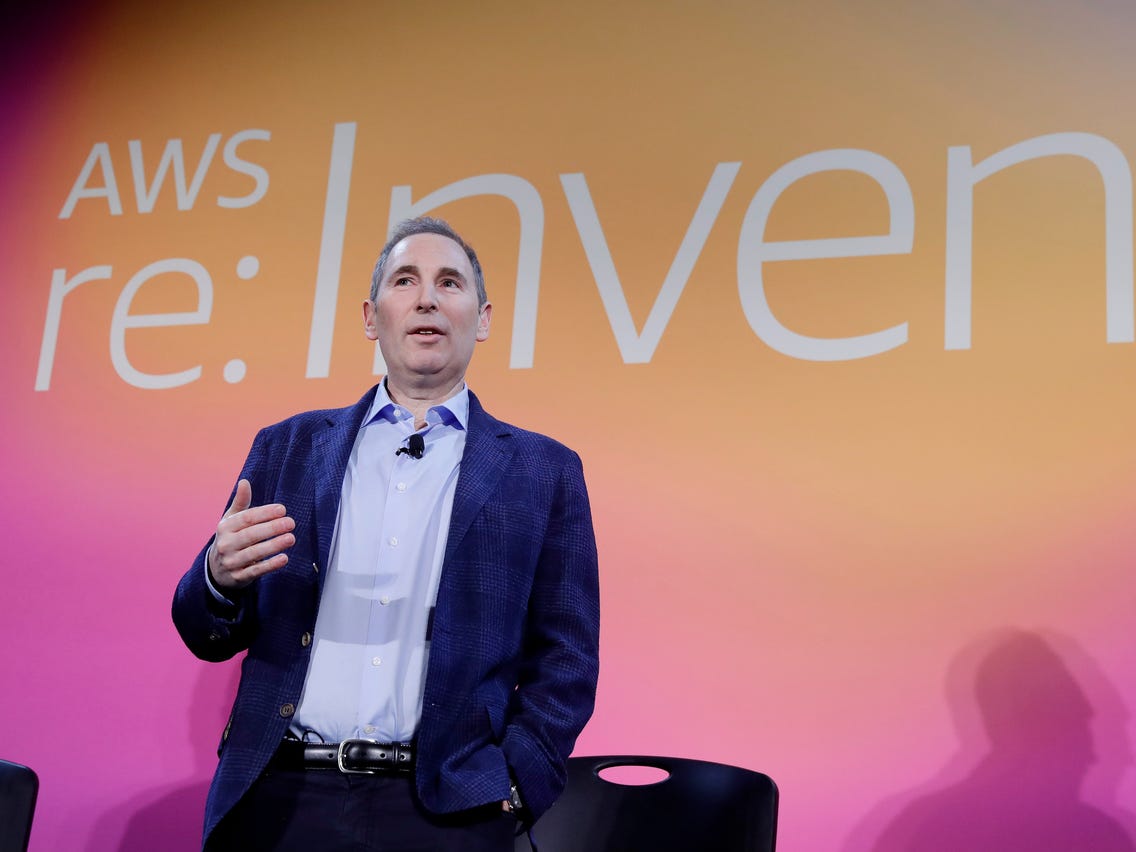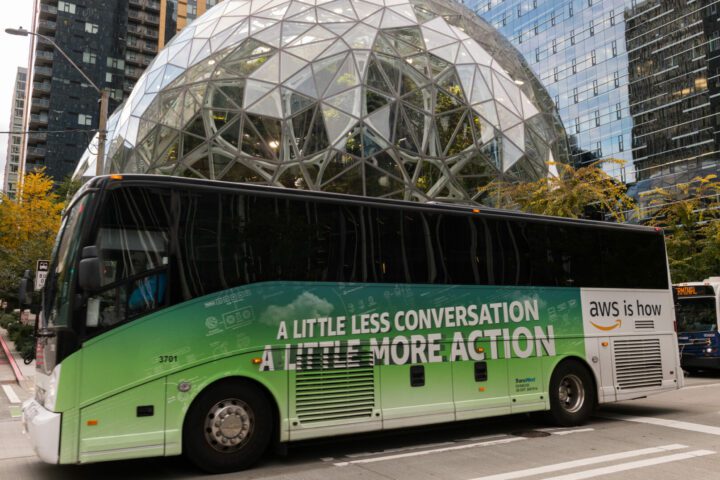50 shades of green – Amazon AWS and sustainability of their data centers
How going green for datacenters is not as benevolent as it sounds. A thesis and anti-thesis form of essay, having in mind the AWS case study.
Amazon Web Services Inc. (AWS) is the biggest cloud computing provider, owning nearly 50% of the entire public cloud infrastructure (Baptiste, 2019). It’s Simple Storage Service (S3) is a pioneering cloud solution that hoisted the entire Infrastructure-as-a-service industry (Swartz, 2019). Modern content consumption trends such as Netflix binge watching or seamless BBC media streaming are all powered by AWS – an infrastructure that is both scalable and relatively cheap (Saunders,2020). AWS currently holds around 32,4% of the global cloud revenue share, while two biggest competitors, Microsoft Azure and Google Cloud hold 17,6% and 6% respectively (Canalys, 2019).

Patrizio (2020) elaborates that IT industry shift towards cloud computing is benevolent for the planet as it reduces electrical waste, recycling and inefficiencies of handling decentralized IT equipment – during the 2010-2020 period, cloud computing power increased by 550% while energy consumption rose only 6% (Year-over-Year).
Nevertheless, cloud scalability and infrastructure comes with an environmental cost. It is approximated that data centers (physical storage spaces where servers are located) use 205 TWh of electricity each year (Kamiya, 2020). This kind of electricity generates approximately 142.000.000 metric tons of carbon dioxide and is around 2% of the entire global electricity consumption – same pollution levels as the complete aviation industry (Trueman, 2019).
Thesis
IT stakeholders (especially AWS competitors) have been loud proponents of sustainable data centers deployment (Oberhaus, 2019). Both Google and Microsoft achieved 100% sustainability – their data centers electricity usage is lower than the electricity these companies create through wind or solar plants. AWS claims that it reached 50% of sustainability to date and has commitment plans to be 100% sustainable by 2025.
There are two main problems with this plan:
- generating new sustainable electricity does not negate the effects of current electricity from non-renewable sources
- Cloud computing demand is rising constantly and there are legitimate fears that AWS will never be able to achieve 100% sustainability (Greenpeace, 2017)
The issue is technological in nature, but AWS “tokenistically” incorporates only used electricity their plans – hardware, distribution of servers, workforce travel, construction waste and sub-optimal locations of data centers are not taken into account while calculating the balance of AWS data centers sustainability (Schaefer et al, 2015, p. 141, Figure 3). In short, AWS is expedient about the approach and behaving like a “convenient green” customer (Schaefer et al, 2015, p. 160). We will use STEP analysis to elaborate further on market context.
Social
AWS presents itself as a leader in cloud sustainability, but their biggest problem is lack of transparency. Netflix, BBC and similar key AWS accounts are not eligible to receive data to measure their impact on global pollution (Greenpace, 2017). AWS did publish overall energy consumption (500 – 650 MW), but they do not publish studies on their data center location sustainability levels. i.e. cloud customers do not know whether the Hong Kong data center is “greener” than the Virginia location.
AWS is “going green” to satisfy social pressure from the IT industry (as Microsoft and Google have already completed their sustainability goals), but has limited technical or business need to do so – reflecting the state of semi-transparency.

Technology
Data center power usage is first and foremost a technical challenge. AWS and similar companies could tackle this problem from several angles:
- Optimizing data center locations
- Optimizing the usage and purchasing of hardware to run the cloud infrastructure
- Educating clients and cloud users to efficiently use virtual cloud infrastructure and not to accrue cost over time
- Building data centers along with renewable power sources directly tied with data center expansion plan
Instead, AWS and its competitors are basically throwing money at the problem by building sustainable solar and wind power plants, but not at the same rate as constructing new data centers. This AWS mindset is closer to 1980s ‘Environmental’ Green Marketing than modern sustainability approaches (Schaefer et al, 2015, p. 153)
Economic
First economic problem lies within the fact that AWS is ramping up new data centers faster than their ability to provide sustainable energy sources. The company has made significant investments in Ohio, UK, India and Virginia data centers, all of which are coal-powered locations.
Renewable energy procurement is a second economic problem. Company made three deals in the United States during 2015 – AWS signed Power Purchase Agreements (PPAs), but it did not generate its own Renewable Energy Certificate (REC). Instead, AWS plainly bought external RECs from the national pool, again, throwing money at the problem. (Greenpeace, 2017)
Last economic problem is advocacy about renewable energy, especially in Virginia. This state is considered a “data center alley” – 70% of all internet traffic is going through Virginia and most IT companies host data centers there. AWS did advocate for sustainability of this state energy usage, either by joining Clean Power Plan Amicus Brief or negotiating a unified power usage bill with Dominion Virginia Power, but the growth rate of datacenter locations in this state was not enough to mitigate the need for coal based energy sources.

Physical
AWS does not release data about exact pollution and physical effects it’s datacenters have on the environment. Google, on the other hand, releases exact measures and documents of efficiency and pollution prevention, down to the details of data centers PUE (Power Usage Effectiveness). Whole IT industry is currently using 7% of global electricity and this could rise up to 20% until the end of 2025 (Craighill, 2019).
Virginia AWS data centers require roughly 4.5 GW of power which is roughly the same as output from nine larger coal-based power plants (500 MW each). Looking at a bigger scale, AWS should be transparent about physical damage it does to the Virginia state and on the global level.
Antithesis
Amazon’s challenging and pioneering period in conceiving cloud services started in 2006. First, AWS had to convince the whole world that cloud computing is a better alternative than decentralized IT equipment handling. “Better” in this context means that cloud computing is cheaper, efficient and extensively more “greener” than the old ways of producing and distributing computing globally. Without AWS, cloud concept adoption would lag, further damaging the global ecosystem and making whole IT inefficient. Sahlstrom (2019) elaborates that moving a mid-size company IT infrastructure from “on-premises” to the “cloud” reduces the carbon footprint of the organization by 88%. Although Greenpeace and other critics alarm the world about AWS’s 50% sustainability rate, they should be fair in noting that migrating to AWS cloud is a greener solution in itself. Additionally, companies that have 100% sustainability rate did come to the market many years after AWS and have significantly lower cloud computing scale at their fingertips (Baptiste, 2019).
Implementation of AWS green efforts is coordinated throughout the whole organization. Specifically, AWS is working on all 4 levels of effective “greening” (Schaefer et al, 2015, p. 146):
- AWS sustainability policy is both “Marketing-Led” and “Led From The Top” with several senior officers, including Jeff Bezos, Andy Jassy and Kara Hurst, being loud proponents of AWS’s goal of being 100% sustainable by the end of 2025 (Murray, 2018)
- Plans are “Backed by actions” and “Integrated”. Clear guidelines and timeframes are both visible, measurable and detectable on all online AWS resources (AWS, 2020).

AWS has been an active critic of Greenpeace itself, claiming that the NGO is falsely accusing and badly presenting interpreted data. Major sources from AWS have shown several projects that Greenpeace forgets to mention (Froese, 2019):
- AWS has invested in more than 53 sustainable energy global projects
- Virginia state alone houses 6 of AWS’s renewable energy projects.
- Complete output of these projects is staggering 1.016 MW
- AWS is as transparent as it can be as all of its goals, methods and plans are visible and measurable online.
Green marketing process in AWS is set for success and the company is strongly standing behind it’s sustainable plan. We will take a look at Peattie’s 4S factors (Schaefer et al, 2015, p. 137) and elaborate why this is true.
Satisfaction of Stakeholder needs
Charter wrote (1990) that customers make around 75% of perceived importance in stakeholder influence. AWS is operating in an IT world where employee importance is even higher – all modern IT companies are grasping to preserve it’s workforce and will go lengths to make all employees feel good about the company they work for. AWS is no exception and I would argue that perceived importance of employees’ influence is even 90%. Fierce competition from Microsoft Azure and Google Cloud (both 100% sustainable) will make sure to push AWS in the right direction and become 100% sustainable by 2025. I elaborated before that the “going green” change is led from the top and this is seen in all AWS communication efforts towards consumers and especially employees (Murray, 2018).
Safety of products and processes
Safety of data centers operations is paramount in any cloud computing deployment. All major IT companies invest heavily in working with governments and construction companies to fully envision and plan those greenfield investments. AWS holds all major certifications about cloud operating safety – ISO, ITAR, HIPAA, G-Cloud, SOC 1-2-3 to name a few (AWS Web, 2020)
Social acceptability of the company
Current market share of AWS cloud services is staggering 33% and that is more than the first two competitors combined. Of course, this is not 100% relevant to going green policy and social acceptability, but it’s a sign that companies’ overall market standings are good. AWS is actively working on educating the cloud market – for instance, customers that use AWS services will use 77% less server machines and 84% less power than owning their own IT infrastructure. (AWS ENVIRONMENTAL LAYER Web, 2020)
Sustainability of its activities
AWS’s pledge and operational plan to become sustainable by 2025 is the biggest factor in whether this will be a success or not. Problem is a need to serve its customers in various locations and with more computing power. AWS and its competitors are constantly building new data centers to make what is called a Content Delivery Network – the more nodes you operate, more customers can use your services closer to their business operations which is a “green effect” in itself.
Renewable projects will need to follow the same ramp up pattern – AWS is expected to deliver over 3 billion GWh of renewable energy yearly. Also, AWS will host solar energy panels at 50 fulfillment centers by the end of 2020. (Business Wire, 2019) On top of that, green projects generate hundreds of jobs and provide more than tens of millions of USD of local communities investment (AWS Web, 2020).
Synthesis
Cloud computing is an enabler of many modern activities – extensive social media usage, content consumption and remote work operations (last one being a crucial factor while we battle Covid-19 pandemic). Consumers take all these moments for granted and expect availability of services on any device and any occasion. AWS has been an undisputed pioneer and a driving force of these technological progressions and has consequently built a massive array of data centers around the globe.
AWS’s force to propagate cloud concepts has been benevolent toward the global ecosystem – companies will reduce a staggering 88% of carbon footprint if they switch their IT operations to cloud. In other words, companies provision fewer than ⅕ of the servers they would normally provision on-premises. Also, AWS has a clear sustainability plan and more importantly, has taken care of all 4 levels of effective greening, especially “Led from the top” initiative (Schaefer et al, 2015, p. 146).
Of course, AWS could act expeditious about making their whole cloud operations more sustainable. Both Google and Microsoft presented that “throwing money” at the problem by building arrays of renewable power plants and achieving 100% sustainability actually works. It is not evident or transparent why AWS has not used it’s vast cash reserves and started building more than 53 renewable projects. The company clearly says their plan is to achieve 100% sustainability by 2025, but they don’t explain why they could not speed up the plan or why they choose a fairly distant goal. Operations, human resources, know-how and financial resources are obviously not a problem and this semi-transparency is the biggest issue with AWS goals. Trueman argues (2019) that this lack of transparency is resulting from AWS’s need to win business from the Oil & Gas industry, but these are only speculations. It is odd why the cloud pioneer (and an obvious IT behemoth) let Google and Microsoft beat them to this objectively good and planetary useful goal. It is not evident whether this was a PR, operations or technical fail.
Arguments suggest that AWS has two key ingredients and overall positive balance towards sustainability:
- Their pioneering push of cloud technologies has reduced carbon footprint of the whole IT industry
- Company is not yet 100% sustainable in terms of cloud datacenter operations, but has a clear goal and management support in doing so.
In the end, I believe that stakeholders and the pure market will push AWS to become fully sustainable and that giant cloud companies (AWS, MS, Google) will produce new technologies and server utilization techniques that will help other companies further reduce IT carbon footprint.
References
Amazon Web Services inc., 2020, AWS & Sustainability, available at https://aws.amazon.com/about-aws/sustainability/
Baptiste Jean, 2019, Amazon Owns Nearly Half Of The Public-Cloud Infrastructure Market Worth Over $32 Billion, available at https://www.forbes.com/sites/jeanbaptiste/2019/08/02/amazon-owns-nearly-half-of-the-public-cloud-infrastructure-market-worth-over-32-billion-report/
Business Wire, 2019, Amazon Announces Three New Renewable Energy Projects to Support AWS Global Infrastructure, available at https://www.businesswire.com/news/home/20190408005471/en/Amazon-Announces-New-Renewable-Energy-Projects-Support
Canalys, 2019, Cloud Channels Analysis, available at https://www.canalys.com/analysis/cloud+channels+analysis
Charter Martin, 1990, The Greener Employee, KPH Marketing, Alton
Craighill Cassady, 2019, Greenpeace Finds Amazon Breaking Commitment to Power Cloud with 100% Renewable Energy , available at https://www.greenpeace.org/usa/news/greenpeace-finds-amazon-breaking-commitment-to-power-cloud-with-100-renewable-energy/
Froese Michelle, 2019, Amazon responds to Greenpeace report — remains committed to 100% renewables, available at https://www.windpowerengineering.com/amazon-responds-to-greenpeace-report-remains-committed-to-100-renewables/
Greenpeace.Org, 2017, Clicking Clean: Who is winning the race to build a green internet?, available at https://www.greenpeace.de/sites/www.greenpeace.de/files/publications/20170110_greenpeace_clicking_clean.pdf
Kamiya George, 2020, Data Centres and Data Transmission Networks, available at https://www.iea.org/energy-system/buildings/data-centres-and-data-transmission-networks
Koma Alex, 2019, Activists Use Life-Sized Amazon Echo to Protest Company’s Energy Practices in Crystal City
Levy Ari, 2017, Amazon cloud chief jabs Oracle: ‘Customers are sick of it’, available https://www.cnbc.com/2017/04/19/amazon-aws-chief-andy-jassy-on-oracle-customers-are-sick-of-it.html
Murray Tom, 2018, Amazon’s Big Opportunity: Transparency In Sustainability, available at https://www.forbes.com/sites/edfenergyexchange/2018/04/02/amazons-big-opportunity-transparency-in-sustainability/
Oberhaus Daniel, 2019, Amazon, Google, Microsoft: Here’s Who Has the Greenest Cloud, available at https://www.wired.com/story/amazon-google-microsoft-green-clouds-and-hyperscale-data-centers/
Patrizio Andy, 2020, Data-center power consumption holds steady, available at https://www.networkworld.com/article/3531316/data-center-power-consumption-holds-steady.html
Sahlstrom Nat, 2019, Reducing carbon by moving to AWS, available at https://blog.aboutamazon.com/sustainability/reducing-carbon-by-moving-to-aws
Saunders Ben, 2020, Who’s Using Amazon Web Services? [2020 Update],available at https://www.contino.io/insights/whos-using-aws
Schaefer Anja, Fiona Harris, Helen Roby and Marylyn Carrigan, based on a draft by David Faulkner, 2015, B324 Block 3 Responsible business marketing, Milton Keynes, The Open University.
Schmidt Franka, 2019, How much carbon is your server emitting?, available at https://blog.mapbox.com/how-much-carbon-is-your-server-emitting-d7edf3496fd6
Swartz Jon, 2019, How Amazon created AWS and changed technology forever, available at https://www.marketwatch.com/story/how-amazon-created-aws-and-changed-technology-forever-2019-12-03
Stalcup Katy, 2020, AWS vs Azure vs Google Cloud Market Share 2020: What the Latest Data Shows, available at https://www.parkmycloud.com/blog/aws-vs-azure-vs-google-cloud-market-share/
Trueman Charlotte, 2019, Why data centres are the new frontier in the fight against climate change, available at https://www.computerworld.com/article/3431148/why-data-centres-are-the-new-frontier-in-the-fight-against-climate-change.html







